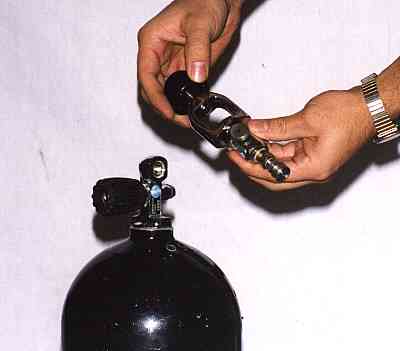

[Home] [Airsmith
Services] [Machine Shop] [Tinker's
Guild] [Technical Section] [Links]
[Site
News] [The Galleries] [Doc's
Gear] [Site Navigator] [Classifieds]
[Contact Us]
Okay, you fell for the hype and marketing
pressure and blew two months salary on a nitrogen setup for your paintgun. With a
bit of fiddling around, you got it attached to the gun, plumbed, and ready to fill...
NOW WHAT?!?
Don’t panic, stay calm. If handled carefully and with proper respect,
high pressure gas is quite safe. Here are some simple and straightforward guidelines
to help you fill and use your HP system properly and safely.
First off, we
must assume you already have some source of HP gas, whether its a SCUBA tank or industrial
nitrogen bottle. The procedures are very similar when using a hose with a slide-check
hooked directly to a compressor. For private individuals, and presuming your local
field allows ‘walk-on air’, we recommend a 80 to 90 cubic foot (CF) SCUBA tank, and
a commercial SCUBA fill station as an inexpensive, reliable, easy to carry supply
of a day’s air. Tanks can be bought used often as low as $100 or less, and a good
fill station retails around $60 to $90. A 90 CF SCUBA fill shouldn’t cost much more
than $5 to $10. When buying used tanks, be ABSOLUTELY certain the tank is “in test”,
or currently certified to be filled to high pressures. If the tank is out of test,
get a written agreement with the seller for a complete refund if the tank does not
pass hydrostatic testing, before you buy it.
Individuals can also own some
of the smaller industrial nitrogen tanks, up to about a 124 CF size, or you can lease
larger ones, up to around 300 CF. Unfortunately, most N2 tanks only provide 2,000
to 2,200 psi, and even a small 124 is significantly larger and heavier than a SCUBA
tank. In this application, it’s a good idea to get three or four players together,
and split the cost of both the lease and weekly filling of a larger, higher pressure
industrial nitrogen tank. Expect the lease to be in the $10 per month range, and
fills/exchanges in the $45 to $60 range. Depending on your gas supplier, N2 tanks
can be had in pressures up to the 6,000 psi range, so ask what they might have available,
and check costs. However, these larger tanks can also weight in the 300 pound range,
making loading and unloading difficult. If your supply is capable of pressures higher
than the on-gun tanks will handle, for example, a 4,500 psi source, but only a 3,000
psi system on the gun, then you should have a regulated fill station. This is a large
industrial high pressure regulator with the proper fittings for filling, which, sadly,
also costs about $250 to $300.
Okay, we have the HP supply, lets fill something.
Basics
of filling HPA Systems:
For the most part, filling HP is easy; Often you
have a gauge to watch so you can see at a glance how full the tank is, and
the fill nipples are essentially automatic. There are some different systems out
there, so be sure of the proper procedure before filling. For example, the PMS MiniReg
has a unique “cap” that must be used to properly fill a Mini’s bottle. This cap doesn’t
have a check valve in the nipple, the bottle’s valve does that. Remember to open
it before filling. Max Flows are similar; the tank has a shutoff valve that must
be opened before it will fill. Also remember to keep the fill nipple capped in some
way. If dirt, crud or paint get in there, the next fill can and will blow it into
the tank, where it will contaminate the regulator, possibly causing overpressure
situations or damage. A simple rubber cap is cheap, easy and replaceable, or the
new aluminum quick disconnect covers are trick and effective.
Using the fill station:
SCUBA
fill stations usually have a “hoop” that wraps around the top of the valve, and a
heavy screw with a knob to tighten it against the sealing O-ring. (There IS an O-ring
in there, correct? Check that.) You don’t have to lean on the knob, firm hand pressure
is plenty.
Nitrogen tank fill stations thread into the tank's valve, and
usually have an O-ring sealing element. These often need to be 'seated' lightly using
a wrench, though some have a large hand knob for tightening. Again, you don't have
to lean on the wrench; if you do, something is wrong, check the O-rings or for the
presence of dirt or grit.


Once the fill station is attached and secure, make sure the bleed off valve is closed, and then attach the ‘Gun’s tank. Simply attach the fill nipple on the system to the female quick-disconnect on the fill station. DO NOT allow the gun to ‘hang’ from the fill connection! Always keep the gun fully supported while filling.
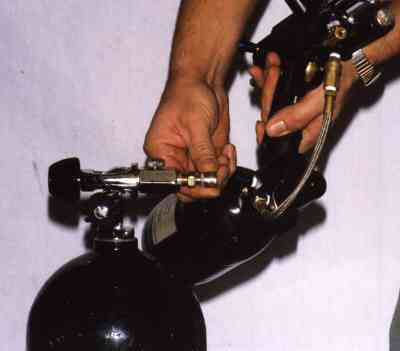
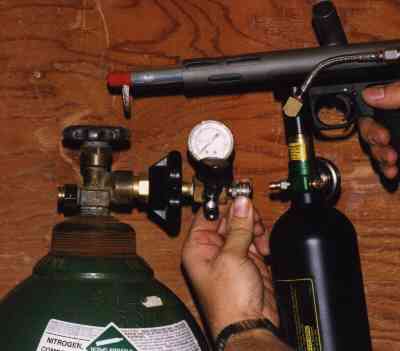
Now, slowly ‘crack’ the big tank’s valve, and keep an eye on the gun-tank’s pressure gauge. If the SCUBA tank is only rated to 3,000 psi and the gun tank is 3K or better, just slowly open the valve and wait for the hissing to stop. If you are filling something lower rated, for example a 1800 psi MicroReg, then VERY carefully watch the tank’s pressure, and stop at the correct level.
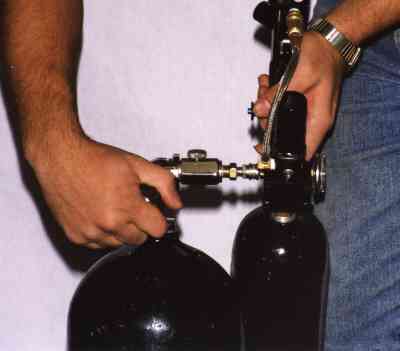
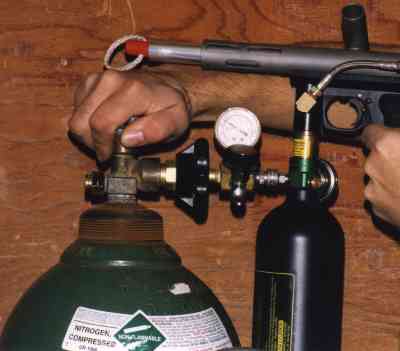
Once the correct pressure is reached, or you can’t hear pressure flowing through, close the big tank’s valve securely, and open the fill station’s ‘bleed valve’ to release the excess pressure. Disconnect the gun tank from the fill station, cap the fill nipple, and you are ready to play.
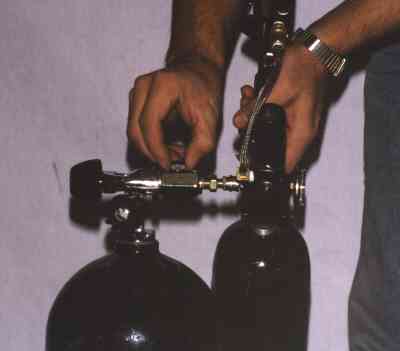
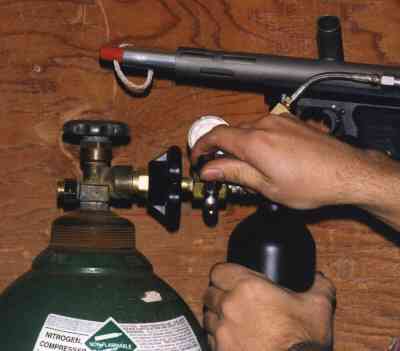
If you have any further questions, or a unique custom setup, talk to your local field operators, store owners, or even your HP gas supplier. If you get nothing but blank stares from them, feel free to drop us a line here. We'll help the best we can.